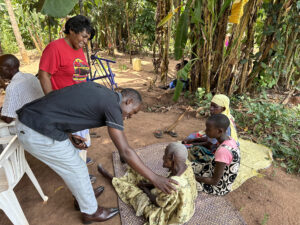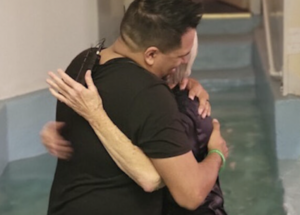
EDITORS’ NOTE: This story is part of a series of stories about couples who adopted embryos. To read the other stories in the series click here, here and here.
NASHVILLE, Tenn. (BP)–Today, an estimated 400,000 frozen human embryos reside in fertility clinics nationwide, stored indefinitely as parents who created them via in vitro fertilization try to make a decision about their future.
Although many scientists say they would best be destroyed and used for stem cell research, a growing number of services across the country are working toward a more ethical goal — finding parents for extra embryos and welcoming them into life.
The California-based Snowflakes Frozen Embryo Adoption Program (www.Snowflakes.org) is the oldest service, founded in 1997. Newer services include the National Embryo Donation Center (www.EmbryoDonation.org) in Tennessee and Embryos Alive (www.EmbryosAlive.com) in Ohio.
All the services have one purpose — providing a chance at birth for embryos that otherwise would be left frozen indefinitely, destroyed for research or simply discarded. Although fertility clinics have, for a while, facilitated anonymous embryo donation, embryo adoption services give donating parents greater freedom in choosing the adopting parents.
“All of us at the NEDC are pro-life,” Jeffrey Keenan, the head of the National Embryo Donation Center, told Baptist Press. “… But I do not think this is simply a Christian or evangelical issue whatsoever. I don’t think that’s required to respect a human embryo.
“A human embryo is an amazing and special being. I have always felt that way,” added Keenan, who, in addition to his work at the NEDC, has his own fertility clinic. “I have never agreed to discard embryos for a patient [at a fertility clinic]. That’s always been a part of my practice, policy and routine.”
Keenan acknowledges he is rare among fertility doctors concerning his view of life.
“There aren’t too many physicians, unfortunately, who have that kind of respect for the embryo,” added Keenan, a member of the Christian Medical & Dental Association.
In vitro fertilization is a fertility procedure in which an egg and a sperm are united in a laboratory, forming an embryo. Because the procedure is so expensive, couples who undergo IVF often have multiple embryos — sometimes more than 20 — produced and frozen. This is done after the woman is given fertility drugs, forcing her body to release numerous eggs.
Typically, an IVF treatment cycle involves transferring two to four embryos into the uterus, with the hope that at least one will implant. If successful, then the parents have extra frozen embryos left over for future use. Their options are limited: use them for another transfer; donate them to research, where they will be destroyed; discard them; indefinitely pay a storage fee; or place them with an adopting couple.
Snowflakes and other embryo adoption services hope that IVF couples increasingly choose that latter option.
Embryo adoption allows infertile couples to experience pregnancy and allows the mother to control the prenatal care of her baby. Additionally, embryo adoption is cheaper than both IVF and traditional adoption. Depending on the provider, embryo adoption can run anywhere from just under $5,000 to around $10,000. If the initial transfer isn’t successful, then the second round is less expensive. Some services perform only open adoptions; others do both open and anonymous adoptions. Couples also must sign an agreement pledging not to undergo a selective abortion if there is a multiple pregnancy.
Megan Corcoran, a spokeswoman for Snowflakes, said she would like to see the day when “people wouldn’t have to create more embryos than they are able to use.”
“[W]hile their first children are growing up. [IVF parents] are burdened with this guilt of, ‘What do we do with these? Are we going to be able to do another one?’ — especially since IVF patients traditionally are older in maternal age,” she told BP. “Placing your embryos for adoption is a beautiful option, but it’s not an easy decision to make…. To offer the solution is wonderful, but to be able to prevent it in the future would be great, too.”
Frozen embryos are at the heart of the stem cell research debate. Although most scientists believe embryonic stem cells have the potential for providing treatments for debilitating diseases, thus far only non-embryonic stem cells (also known as adult stem cells) have produced any therapies. In fact, research on non-embryonic stem cells has produced treatments for at least 67 ailments, according to Do No Harm, a coalition promoting ethics in research.
Supporters of embryo adoption say that instead of destroying embryos for research, they should be given a chance a life in the world.
Just like traditional adoption, embryo adoption involves the adopting parents undergoing a home study. But, unlike traditional adoption, under current law embryo adoptions are considered a transfer of property, and not a person. But — once the legal documents are signed — an embryo adoption is just as binding as a traditional adoption, Corcoran said.
Snowflakes recently celebrated its 100th Snowflake baby. NEDC, which is younger, has 28 ongoing or delivered pregnancies.
“We are contacted by couples from all over the country — and even actually different parts of the world — who want to donate embryos,” Keenan said. “We take care of all the medical and technical arrangements on our end. The embryos come into our facility here. Patients who want to adopt embryos come to us from all over the country. We do all the medical, genetic and social screening on these individuals.
“When all is in order, we bring them back for their embryo transfers right here. We control it very tightly. We know exactly what’s happening to each embryo.”
About three-quarters of frozen embryos survive the thawing process, Keenan said. NEDC then transfers two to three embryos into the woman. More than 50 percent of the couples who have come to NEDC have become pregnant, Keenan said. (Some of those couples required more than one transfer.)
Embryo adoption is an “incredible” option for couples unable to have children, Keenan said. It also provides an ethical option for couples with extra embryos, he added.
“What I would encourage them to do is to think about the fact these are the sibling embryos of their children,” Keenan said of couples with surplus embryos. “Don’t you want those children’s siblings to come to birth? If they had a choice, they would certainly choose to be born rather than stay in cryopreservation forever.”
–30–
















